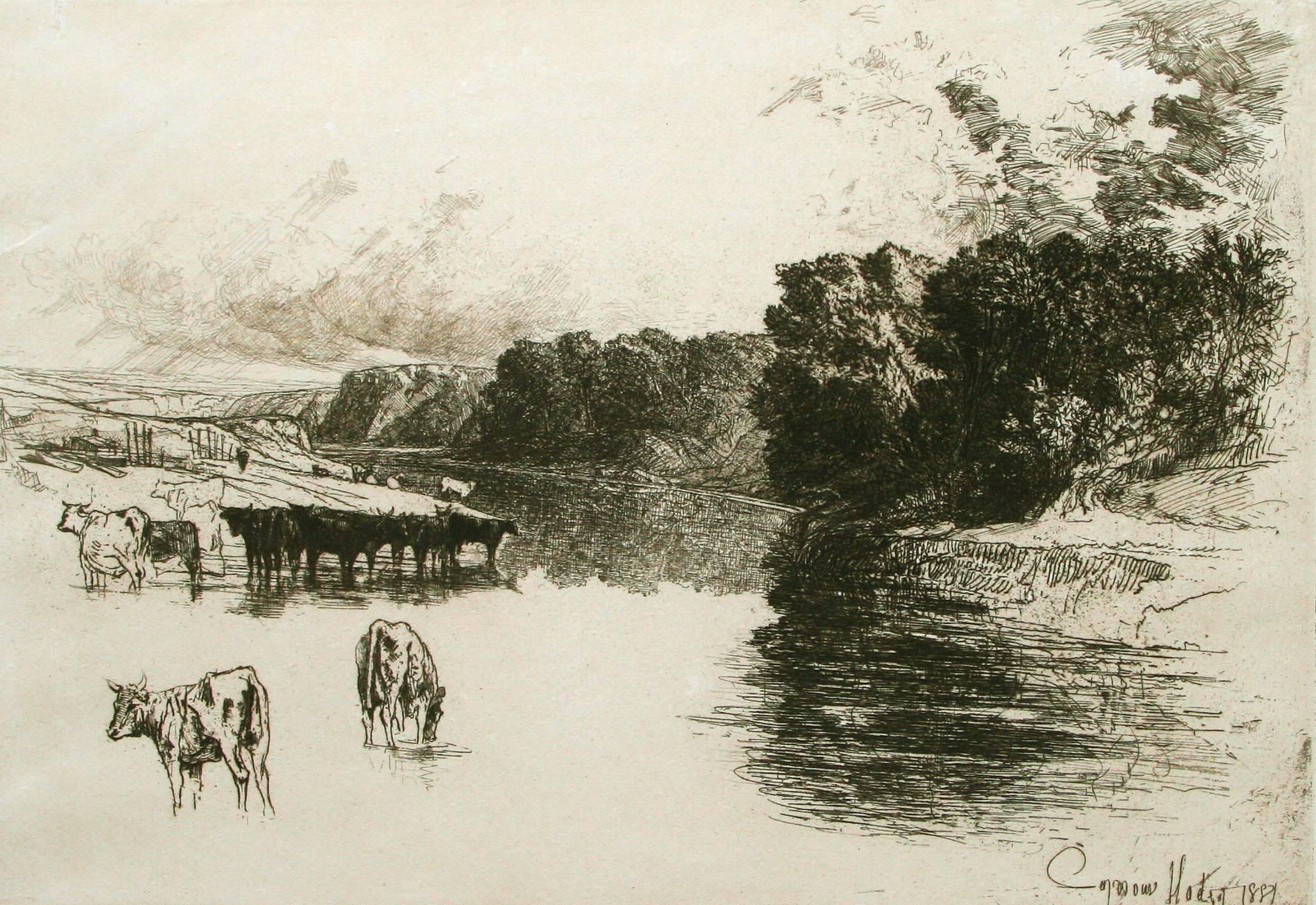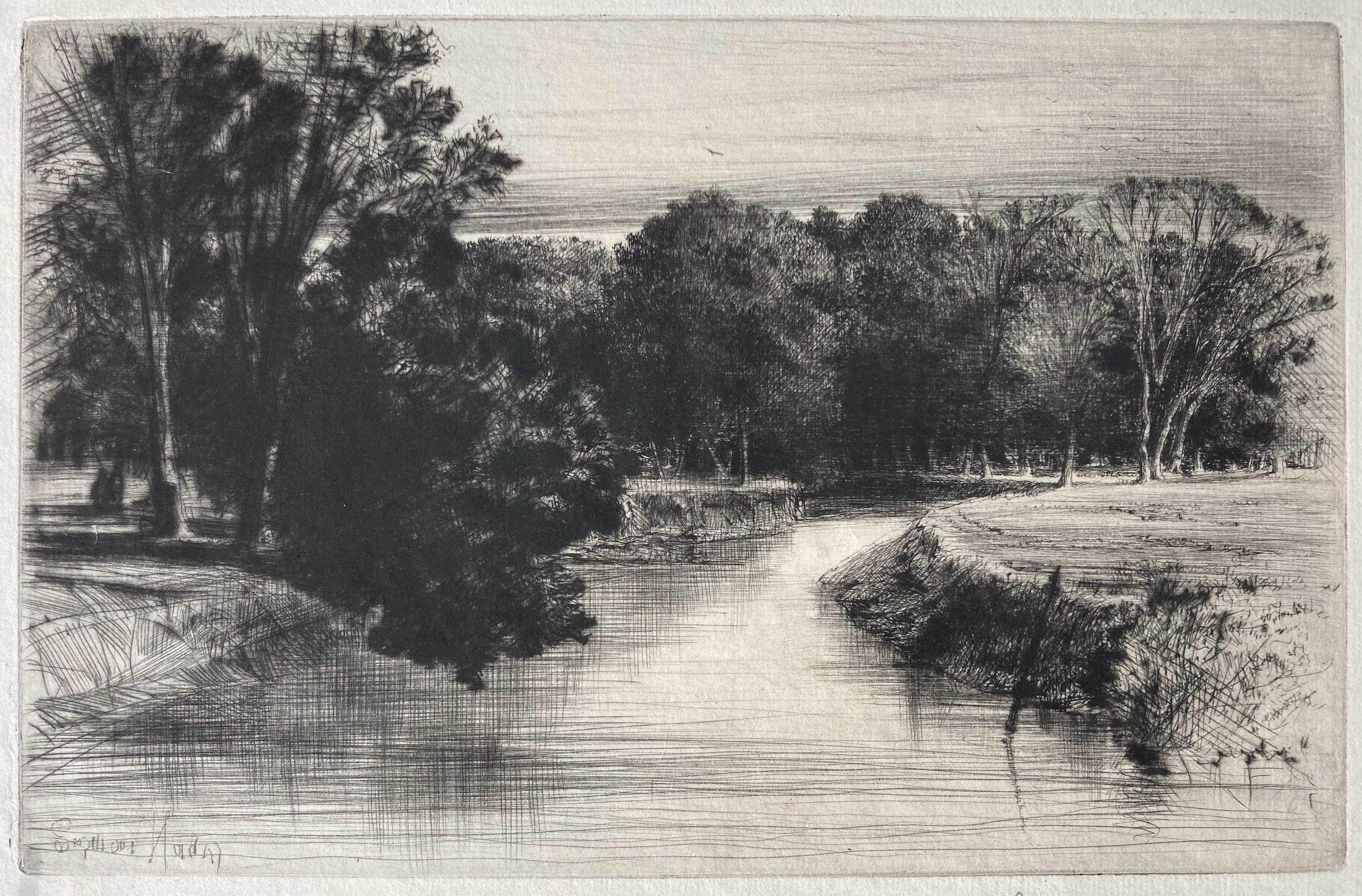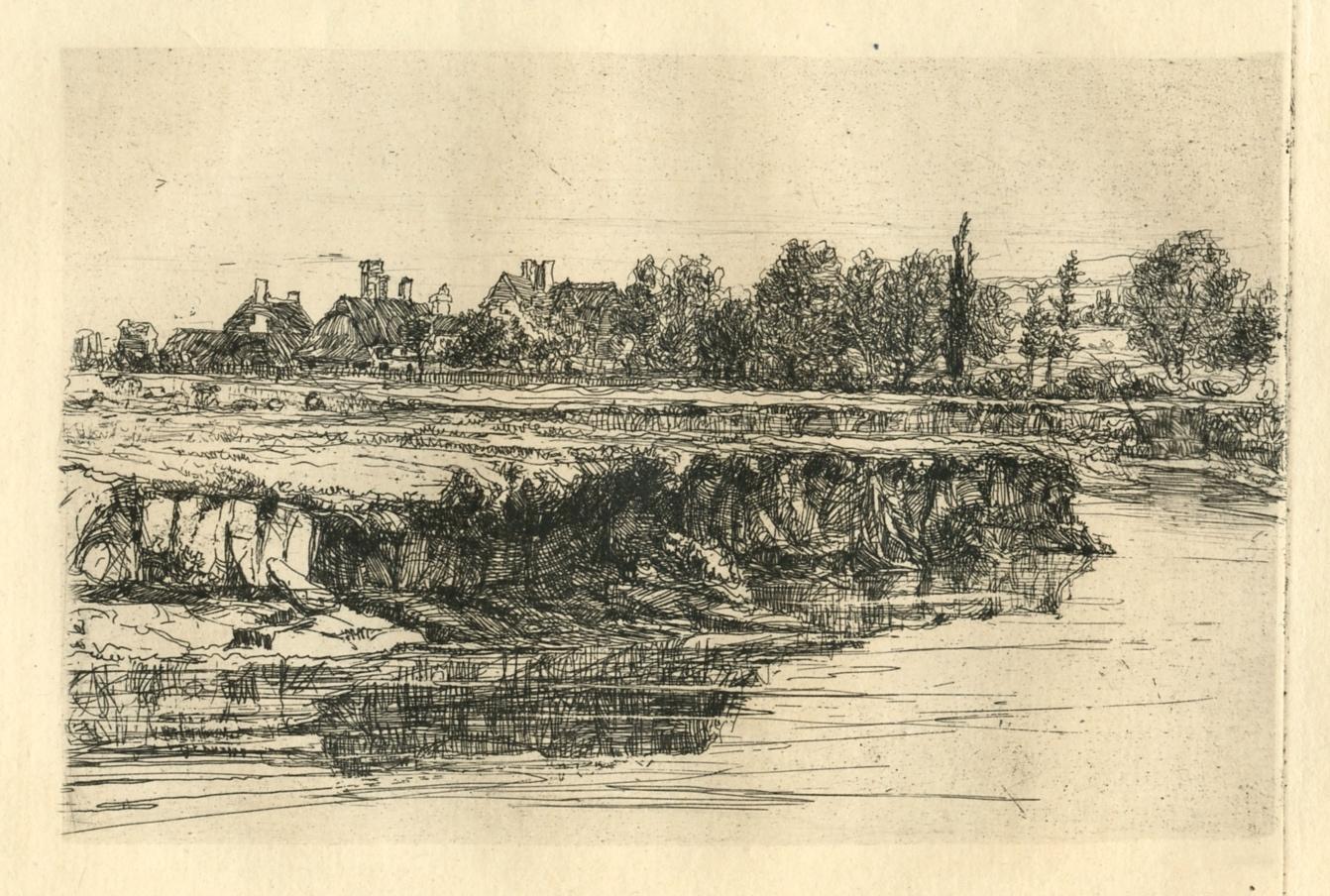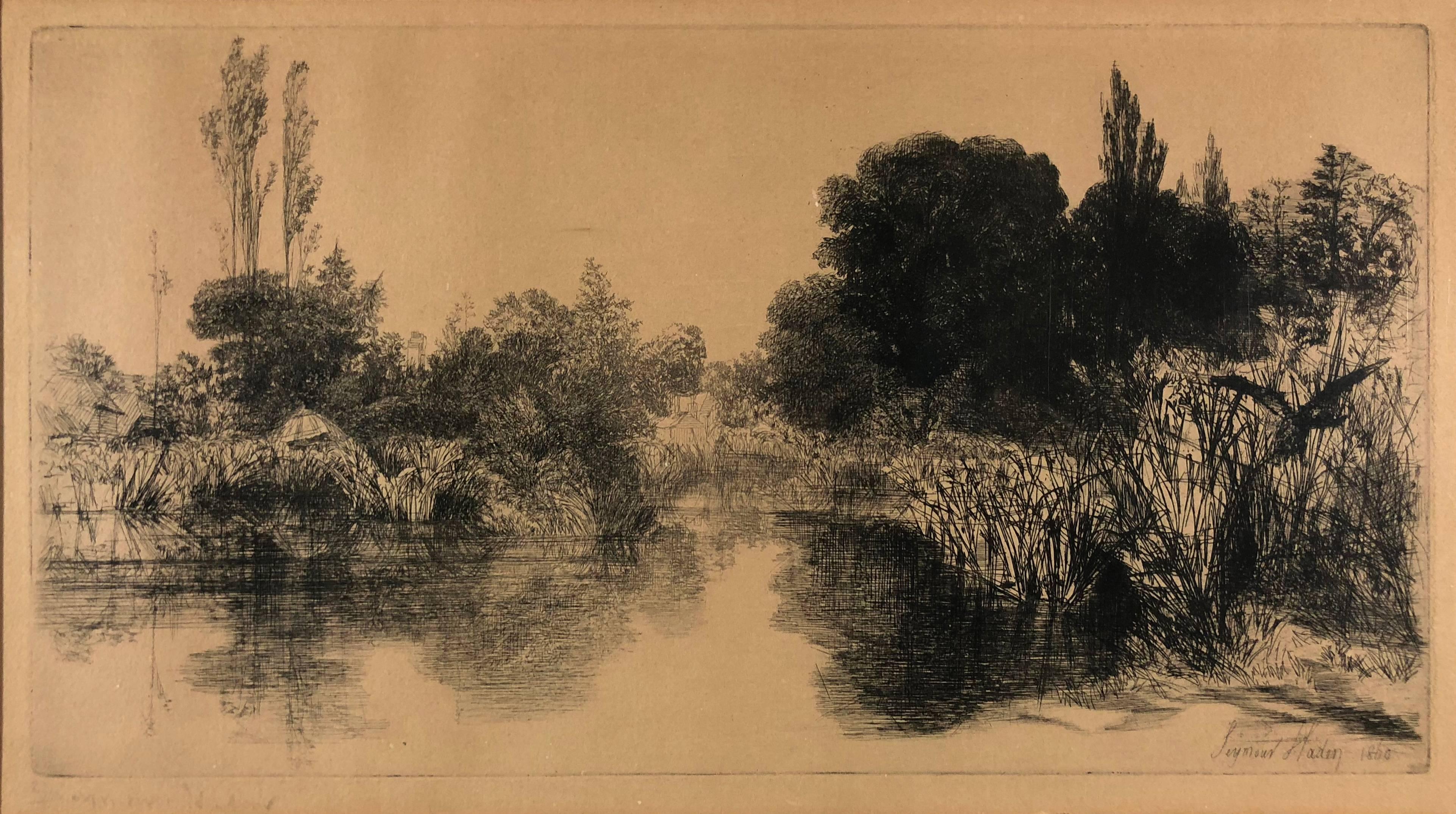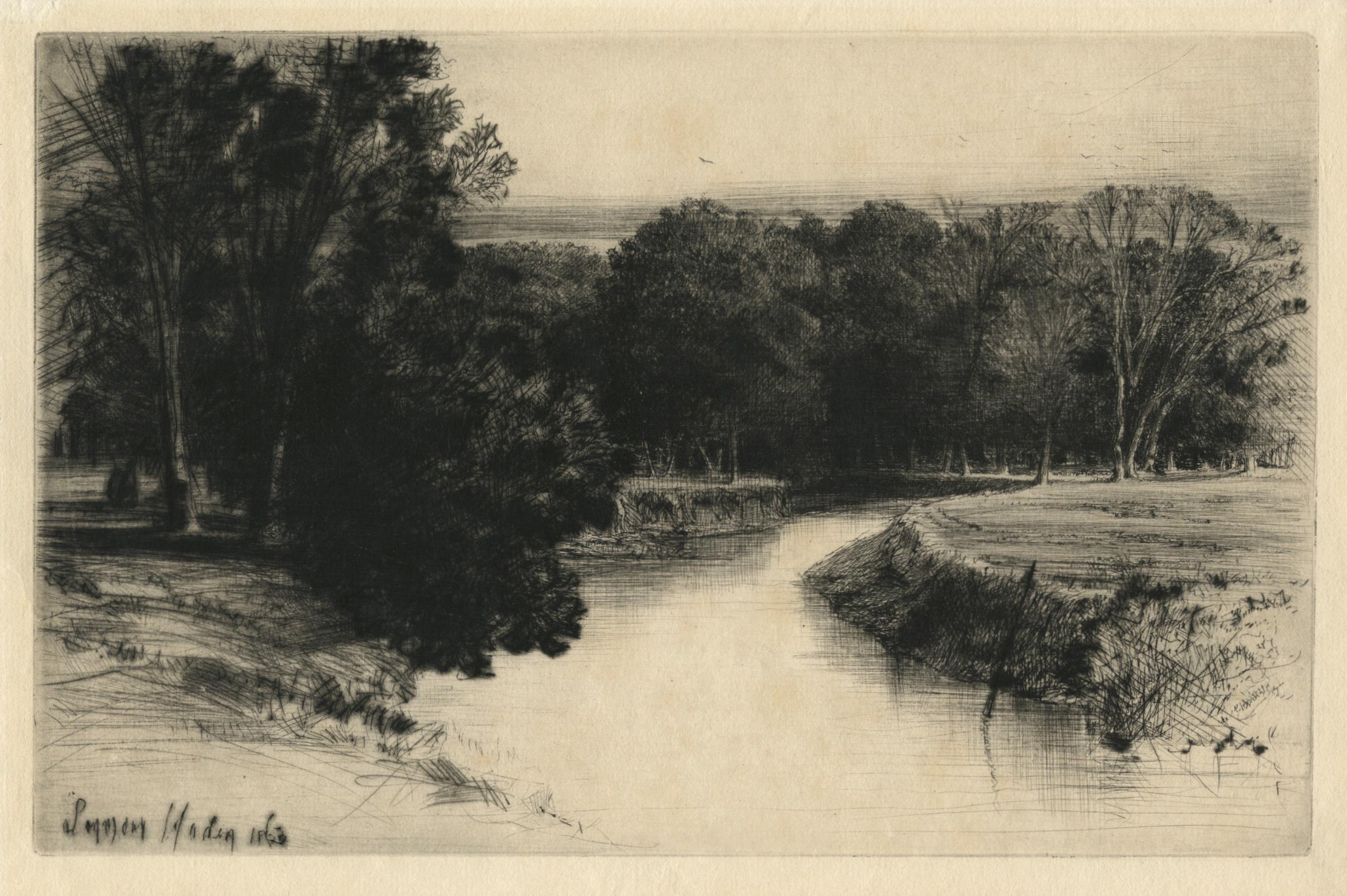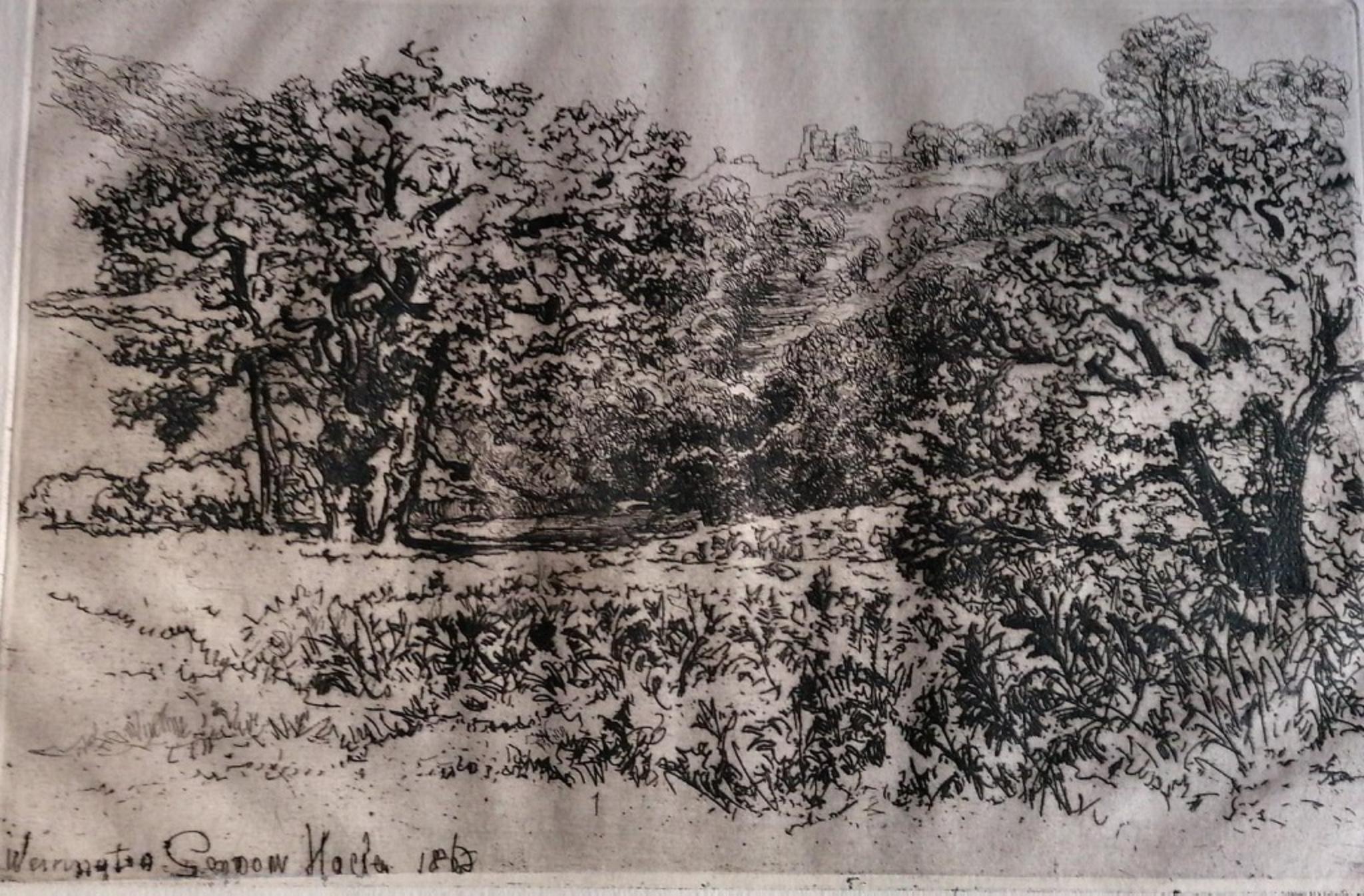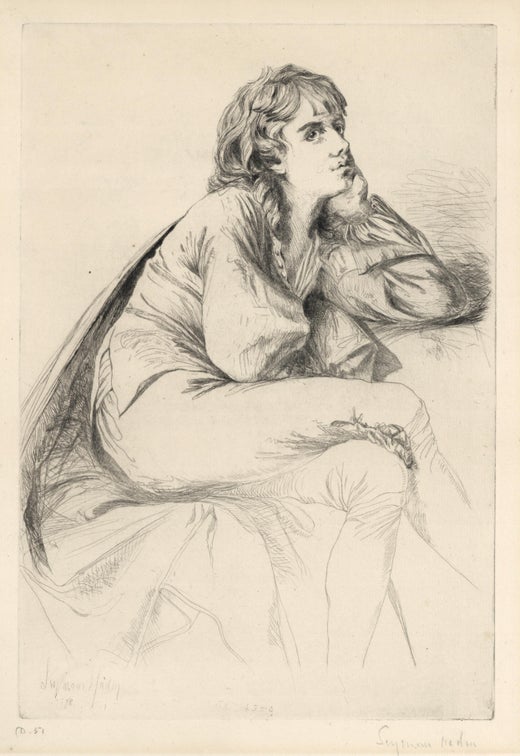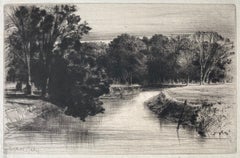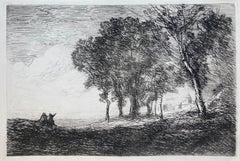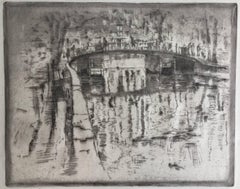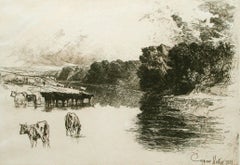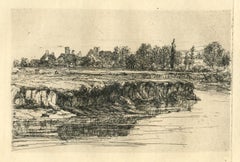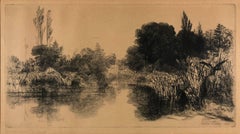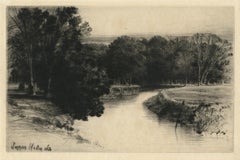Items Similar to A LANCASHIRE RIVER,
Want more images or videos?
Request additional images or videos from the seller
1 of 8
Sir Francis Seymour Haden, R.A.A LANCASHIRE RIVER,1881
1881
$950
£716.94
€820.79
CA$1,339.81
A$1,470.95
CHF 767.40
MX$17,800.54
NOK 9,618.14
SEK 9,062.81
DKK 6,126.95
About the Item
SIR FRANCIS SEYMOUR HADEN (1818-1910)
A LANCASHIRE RIVER, 1881 (Schneiderman 203 viii/ix; Harrington 215 ii/ii)
Original etching with drypoint. Signed in pencil., image 11 x 16. A large sheet, 18 x 22 inches with 3 inch margins.
In very good condition.
According to British dealer Campbell Fine Art, “Francis Seymour Haden regarded this large etching as one of his very finest plates”.
- Creator:Sir Francis Seymour Haden, R.A. (1818 - 1910, British)
- Creation Year:1881
- Dimensions:Height: 11 in (27.94 cm)Width: 16 in (40.64 cm)
- Medium:
- Movement & Style:
- Period:
- Condition:
- Gallery Location:Santa Monica, CA
- Reference Number:1stDibs: LU41137911132
Sir Francis Seymour Haden, R.A.
Sir Francis Seymour Haden CMG FRCS PPRE (16 September 1818 – 1 June 1910), was an English surgeon, best known as an original etcher who championed original printmaking. He was at the heart of the Etching Revival in Britain, and one of the founders of the Society of Painter-Etchers, now the Royal Society of Painter-Printmakers, as its first president. He was also a collector and scholar of Rembrandt's prints.
About the Seller
5.0
Recognized Seller
These prestigious sellers are industry leaders and represent the highest echelon for item quality and design.
Gold Seller
Premium sellers maintaining a 4.3+ rating and 24-hour response times
Established in 1977
1stDibs seller since 2016
293 sales on 1stDibs
Typical response time: 2 hours
Associations
International Fine Print Dealers Association
- ShippingRetrieving quote...Shipping from: Santa Monica, CA
- Return Policy
Authenticity Guarantee
In the unlikely event there’s an issue with an item’s authenticity, contact us within 1 year for a full refund. DetailsMoney-Back Guarantee
If your item is not as described, is damaged in transit, or does not arrive, contact us within 7 days for a full refund. Details24-Hour Cancellation
You have a 24-hour grace period in which to reconsider your purchase, with no questions asked.Vetted Professional Sellers
Our world-class sellers must adhere to strict standards for service and quality, maintaining the integrity of our listings.Price-Match Guarantee
If you find that a seller listed the same item for a lower price elsewhere, we’ll match it.Trusted Global Delivery
Our best-in-class carrier network provides specialized shipping options worldwide, including custom delivery.More From This Seller
View AllSUNSET IN IRELAND (undescribed state?)
By Sir Francis Seymour Haden, R.A.
Located in Santa Monica, CA
SIR FRANCIS SEYMOUR HADEN (British 1818 -1910)
SUNSET IN IRELAND 1863 (Schneiderman 47 - Appears to be an undescribed state between XI and XII)
Etching and drypoint, signed in penci...
Category
1860s Impressionist Landscape Prints
Materials
Drypoint
PAYSAGE D’ ITALIE
By Jean-Baptiste-Camille Corot
Located in Santa Monica, CA
JEAN-BAPTISTE CAMILLE COROT (1876 - 1875)
PAYSAGE D’ ITALIE 1866 (Melot 7 iii/iii)
Etching, plate 6 ¼ x 9 inches, Third state after the removal of the text but before the random scr...
Category
1860s Romantic Landscape Prints
Materials
Etching
Vachère au Bord de l'Eau
By Camille Pissarro
Located in Santa Monica, CA
CAMILLE PISSARRO (French 1830-1903)
VACHERE au BORD de l’EAU 1890 (Delteil 93 viii/viii)
Etching, unsigned as published in “Gazette des Beaux Arts”, Paris, 1890. On laid paper
Very...
Category
1890s Impressionist Figurative Prints
Materials
Drypoint, Etching
$1,463 Sale Price
24% Off
CANAL BRIDGE AMSTERDAM
By John Marin
Located in Santa Monica, CA
JOHN MARIN (1872 -1953)
CANAL BRIDGE AMSTERDAM, 1906 (Zigrosser 13 i/ii)
Etching, drypoint and plate tone. A PROOF IMPRESSION of the 1st state, Annotated...
Category
Early 1900s American Impressionist Landscape Prints
Materials
Etching
$5,100 Sale Price
26% Off
Thames Warehouses
By James Abbott McNeill Whistler
Located in Santa Monica, CA
JAMES McNEILL WHISTLER (American 1834–1903 London)
THAMES WAREHOUSES, 1859 (K 38 ii/ii; Glascow 46 iv/v; Mansfield 37)
Etching and drypoint on fine thin laid paper. Plate: 3 × 8 i...
Category
1850s Impressionist Landscape Prints
Materials
Drypoint, Etching
La Source dans les Bois
By Henri Fantin-Latour
Located in Santa Monica, CA
HENRI FANTIN-LATOUR (French 1836-1904)
LA SOURCE DANS DE BOIS, 1898 (Hédiart. 139; Johnson 41-2)
Lithograph, unsigned, on chine. Image, 11 3/...
Category
1890s Barbizon School Prints and Multiples
Materials
Lithograph
$480 Sale Price
20% Off
You May Also Like
A Lancashire River.
By Sir Francis Seymour Haden, R.A.
Located in Storrs, CT
Schneiderman 203.viii. 10 7/8 x 15 7/8 (sheet 13 7/8 x 17 7/8). Illustrated: Print Collector's Quarterly 1 (1911): 27. A 1-inch printing fold in the left-hand side of the image, and ...
Category
Late 19th Century Landscape Prints
Materials
Etching
"Bit of a River Bank" original etching
By Sir Francis Seymour Haden, R.A.
Located in Henderson, NV
Medium: original etching. This impression on laid paper was printed in 1868 for Philip Gilbert Hamerton's very scarce first volume of "Etching and Etchers". Image size: 4 x 6 1/4 inc...
Category
1860s Landscape Prints
Materials
Etching
Shere Mill Pond
By Sir Francis Seymour Haden, R.A.
Located in Missouri, MO
Shere Mill Pond, No. II (large plate). 1860. Etching and drypoint. Schneiderman 37.v/ix. 7 x 13 1/8 (sheet 10 3/4 x 16 3/8). This state is prior to publication in Études à l'Eau-Forte. Illustrated: Keppel The Golden Age of Engraving; Print Collector's Quarterly 1 (1911): 18; : Guichard, British Etchers, 1850-1940. A rich, brilliant proof with drypoint burr printed on white laid paper. Signed in pencil.
-------------------------------------------------------------------------------------------
Shere Mill Pond, No. II was one of the most highly praised landscape prints of the etching revival. An impression was exhibited at the Royal Academy in 1861 under Haden’s pseudonym, H. Dean. Francis Seymour Haden used this anagram of his own name early in his career as an artist, in order to retain his anonymity and preserve his professional reputation as a surgeon.
Biography:
Sir Francis Seymour Haden (16 September 1818 - 1 June 1910), was an English surgeon, best known as an etcher.
He was born in London, his father, Charles Thomas Haden, being a well-known doctor and lover of music. He was educated at Derby School, Christ's Hospital, and University College, London, and also studied at the Sorbonne, Paris, where he took his degree in 1840. He was admitted as a member of the College of Surgeons in London in 1842.
In 1843-1844, with his friends Duval, Le Cannes and Colonel Guibout, he travelled in Italy and made his first sketches from nature. Haden attended no art school and had no art teachers, but between 1845 and 1848 he studied portfolios of prints belonging to a second-hand dealer named Love, who had a shop in Bunhill Row, the old Quaker quarter of London. Arranging the prints in chronological order, he studied the works of the great original engravers, Albrecht Dürer, Lucas van Leyden and Rembrandt. These studies, besides influencing his original work, led to his important monograph on the etched work of Rembrandt. By lecture and book, and with the aid of the memorable exhibition at the Burlington Fine Arts Club in 1877, he tried to give a true reflection of Rembrandt's work, giving a nobler idea of the master's mind by taking away from the list of his works many dull and unseemly plates that had long been included in the lists. His reasons were founded upon the results of a study of the master's works in chronological order, and are clearly expressed in his monograph, The Etched Work of Rembrandt critically reconsidered, privately printed in 1877, and in The Etched Work of Rembrandt True and False (1895).
Haden's printmaking was invigorated by his much younger brother-in-law, James Whistler, at the Haden home in Sloane Street in 1855. A press was installed there and for a while Haden and Whistler collaborated on a series of etchings of the Thames. The relationship and project did not last.
Haden followed the art of original etching with such vigour that he became not only the foremost British exponent of that art but brought about its revival in England. His strenuous efforts and perseverance, aided by the secretarial ability of Sir WR Drake, resulted in the foundation of the Royal Society of Painter-Etchers and Engravers. As president he ruled the society with a strong hand from its first beginnings in 1880.
Notwithstanding his study of the old masters of his art, Haden's own plates were very individual, and are particularly noticeable for a fine original treatment of landscape subjects, free and open in line, clear and well divided in mass, and full of a noble and dignified style of his own. Even when working from a picture his personality dominates the plate, as for example in the large plate he etched after J.M.W. Turner's "Calais Pier," which is a classical example of what interpretative work can do in black and white. Of his original plates, more than 250 in number, one of the most notable was the large "Breaking up of the Agamemnon."
An early plate, rare and most beautiful, is "Thames Fisherman". "Mytton Hall" is broad in treatment, and a fine rendering of a shady avenue of yew trees leading to an old manor-house in sunlight. "Sub Tegmine" was etched in Greenwich Park in 1859; and "Early Morning--Richmond", full of the poetry and freshness of the hour, was done, according to Haden, actually at sunrise. One of the rarest and most beautiful of his plates is "A By-Road in Tipperary"; "Combe Bottom" is another; and "Shere Mill Pond" (both the small study and the larger plate), "Sunset in Ireland," "Penton Hook," "Grim Spain" and "Evening Fishing, Longparish," are also notable examples of his genius. A catalogue of his works was begun by Sir William Drake and completed by Harrington in 1880. During later years Haden began to practise the sister art...
Category
Late 19th Century Old Masters Landscape Prints
Materials
Drypoint, Etching
Sunset in Ireland
By Sir Francis Seymour Haden, R.A.
Located in Middletown, NY
Drypoint etching on watermarked cream wove paper, 5 7/16 x 8 7/16 inches (39 x 215 mm), wide (perhaps full) margins. A very desirable, bright and richly inked impression, with the da...
Category
Mid-19th Century Realist Landscape Prints
Materials
Drypoint, Etching
La Roxerie - Original Etching by Sir Francis Seymour Haden - 1867
Located in Roma, IT
La Roxerie is an original modern artwork realized by the English artist Sir Francis Seymour Haden (1818 – 1910) in 1867.
Original Etching on paper.
Signed and dated on plate on th...
Category
1860s Modern Landscape Prints
Materials
Etching
Wareham Bridge
By Seymour Haden
Located in Missouri, MO
Wareham Bridge
Medium Drypoint
Year of Work 1877-1877
Image Size: approx. 6 in.; Width 8.9 in. / Height 15.2 cm.; Width 22.7 cm.
Sir Francis Seymour Haden (16 September 1818 - 1 June 1910), was an English surgeon, best known as an etcher.
He was born in London, his father, Charles Thomas Haden, being a well-known doctor and lover of music. He was educated at Derby School, Christ's Hospital, and University College, London, and also studied at the Sorbonne, Paris, where he took his degree in 1840. He was admitted as a member of the College of Surgeons in London in 1842.
In 1843-1844, with his friends Duval, Le Cannes and Colonel Guibout, he travelled in Italy and made his first sketches from nature. Haden attended no art school and had no art teachers, but between 1845 and 1848 he studied portfolios of prints belonging to a second-hand dealer named Love, who had a shop in Bunhill Row, the old Quaker quarter of London. Arranging the prints in chronological order, he studied the works of the great original engravers, Albrecht Dürer, Lucas van Leyden and Rembrandt. These studies, besides influencing his original work, led to his important monograph on the etched work of Rembrandt. By lecture and book, and with the aid of the memorable exhibition at the Burlington Fine Arts Club in 1877, he tried to give a true reflection of Rembrandt's work, giving a nobler idea of the master's mind by taking away from the list of his works many dull and unseemly plates that had long been included in the lists. His reasons were founded upon the results of a study of the master's works in chronological order, and are clearly expressed in his monograph, The Etched Work of Rembrandt critically reconsidered, privately printed in 1877, and in The Etched Work of Rembrandt True and False (1895).
Haden's printmaking was invigorated by his much younger brother-in-law, James Whistler, at the Haden home in Sloane Street in 1855. A press was installed there and for a while Haden and Whistler collaborated on a series of etchings of the Thames. The relationship and project did not last.
Haden followed the art of original etching with such vigour that he became not only the foremost British exponent of that art but brought about its revival in England. His strenuous efforts and perseverance, aided by the secretarial ability of Sir WR Drake, resulted in the foundation of the Royal Society of Painter-Etchers and Engravers. As president he ruled the society with a strong hand from its first beginnings in 1880.
Notwithstanding his study of the old masters of his art, Haden's own plates were very individual, and are particularly noticeable for a fine original treatment of landscape subjects, free and open in line, clear and well divided in mass, and full of a noble and dignified style of his own. Even when working from a picture his personality dominates the plate, as for example in the large plate he etched after J.M.W. Turner's "Calais Pier," which is a classical example of what interpretative work can do in black and white. Of his original plates, more than 250 in number, one of the most notable was the large "Breaking up of the Agamemnon."
An early plate, rare and most beautiful, is "Thames Fisherman". "Mytton Hall" is broad in treatment, and a fine rendering of a shady avenue of yew trees leading to an old manor-house in sunlight. "Sub Tegmine" was etched in Greenwich Park in 1859; and "Early Morning--Richmond", full of the poetry and freshness of the hour, was done, according to Haden, actually at sunrise. One of the rarest and most beautiful of his plates is "A By-Road in Tipperary"; "Combe Bottom" is another; and "Shere Mill Pond" (both the small study and the larger plate), "Sunset in Ireland," "Penton Hook," "Grim Spain" and "Evening Fishing, Longparish," are also notable examples of his genius. A catalogue of his works was begun by Sir William Drake and completed by Harrington in 1880. During later years Haden began to practise the sister art...
Category
1870s Other Art Style Landscape Prints
Materials
Etching
